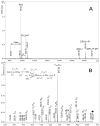First Report on the Streptococcusgallolyticus (S. bovis Biotype I) DSM 13808 Exopolysaccharide Structure
- PMID: 36233098
- PMCID: PMC9570385
- DOI: 10.3390/ijms231911797
First Report on the Streptococcusgallolyticus (S. bovis Biotype I) DSM 13808 Exopolysaccharide Structure
Abstract
Streptococcus gallolyticus subspecies gallolyticus, known as Streptococcus bovis biotype I, is a facultative pathogen causing bacteraemia, infective endocarditis and sepsis that has been linked with colorectal cancer (CRC), but this correlation is still unclear. Bacterial surface structures, such as the major sugar antigens exposed to the outside of the microorganism, are potential virulence factors. One of the primary sugar antigens loosely attached to the cell surface is the biofilm component, exopolysaccharide (EPS). EPSs of S. bovis are poorly characterized molecules. Until now, only one S. macedonicus Sc136 EPS structure was known to the entire S. bovis group. The S. gallolyticus DSM 13808 EPS was investigated by chemical analysis, mass spectrometry and nuclear magnetic resonance (NMR) spectroscopy. The hexasaccharide repeating unit of the EPS, containing four Glc, two Rha residues and one phosphate group, has been described " →6)-α-d-Glcp-(1→3)-β-l-Rhap-(1→4)-β-d-Glcp-(1→3)-[β-d-Glcp-(1→2)]-α-l-Rhap-(1→2)-α-d-Glcp-(1→P→".
Keywords: EPS; NMR; Streptococcus bovis (biotype I); Streptococcus gallolyticus; exopolysaccharide; mass spectrometry.
Conflict of interest statement
The authors declare no conflict of interest. The funders had no role in the design of the study; in the collection, analyses or interpretation of data; in the writing of the manuscript or in the decision to publish the results.
Figures




Similar articles
-
Streptococcus bovis group and biliary tract infections: an analysis of 51 cases.Clin Microbiol Infect. 2014 May;20(5):405-9. doi: 10.1111/1469-0691.12333. Epub 2013 Aug 30. Clin Microbiol Infect. 2014. PMID: 24033711
-
[Streptococcus gallolyticus (ex S. bovis) bacteremia and its relationship with colonic or hepatobiliary disease and endocarditis].Rev Chilena Infectol. 2015 Aug;32(4):430-4. doi: 10.4067/S0716-10182015000500009. Rev Chilena Infectol. 2015. PMID: 26436787 Spanish.
-
Structure and properties of the exopolysaccharide produced by Streptococcus macedonicus Sc136.Glycobiology. 2001 Feb;11(2):131-9. doi: 10.1093/glycob/11.2.131. Glycobiology. 2001. PMID: 11287400
-
Genomics, evolution, and molecular epidemiology of the Streptococcus bovis/Streptococcus equinus complex (SBSEC).Infect Genet Evol. 2015 Jul;33:419-36. doi: 10.1016/j.meegid.2014.09.017. Epub 2014 Sep 16. Infect Genet Evol. 2015. PMID: 25233845 Review.
-
Clinical Importance of Streptococcus gallolyticus infection among colorectal cancer patients: systematic review and meta-analysis.Clin Infect Dis. 2011 Nov;53(9):870-8. doi: 10.1093/cid/cir609. Epub 2011 Sep 29. Clin Infect Dis. 2011. PMID: 21960713 Review.
References
MeSH terms
Substances
Grants and funding
LinkOut - more resources
Full Text Sources
Medical

